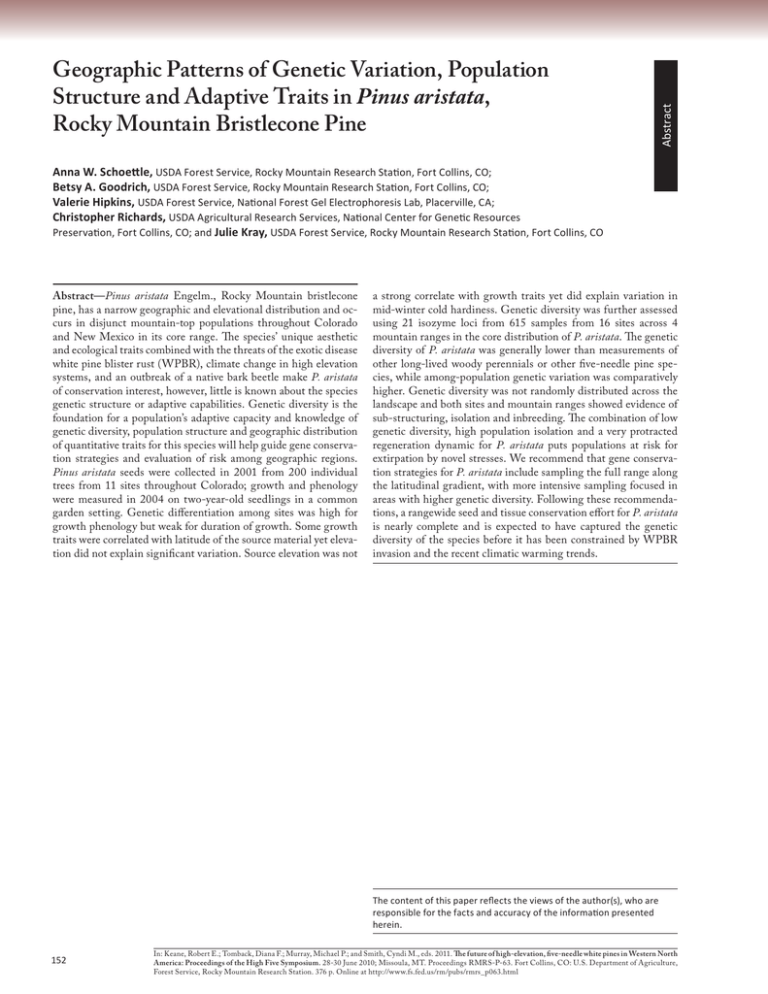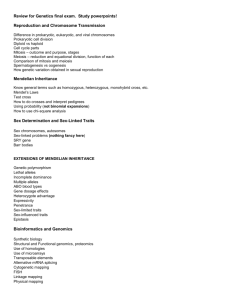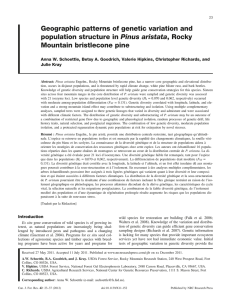Geographic Patterns of Genetic Variation, Population Pinus aristata Rocky Mountain Bristlecone Pine
advertisement

Abstract Geographic Patterns of Genetic Variation, Population Structure and Adaptive Traits in Pinus aristata, Rocky Mountain Bristlecone Pine Anna W. Schoettle, USDA Forest Service, Rocky Mountain Research Station, Fort Collins, CO; Betsy A. Goodrich, USDA Forest Service, Rocky Mountain Research Station, Fort Collins, CO; Valerie Hipkins, USDA Forest Service, National Forest Gel Electrophoresis Lab, Placerville, CA; Christopher Richards, USDA Agricultural Research Services, National Center for Genetic Resources Preservation, Fort Collins, CO; and Julie Kray, USDA Forest Service, Rocky Mountain Research Station, Fort Collins, CO Abstract—Pinus aristata Engelm., Rocky Mountain bristlecone pine, has a narrow geographic and elevational distribution and occurs in disjunct mountain-top populations throughout Colorado and New Mexico in its core range. The species’ unique aesthetic and ecological traits combined with the threats of the exotic disease white pine blister rust (WPBR), climate change in high elevation systems, and an outbreak of a native bark beetle make P. aristata of conservation interest, however, little is known about the species genetic structure or adaptive capabilities. Genetic diversity is the foundation for a population’s adaptive capacity and knowledge of genetic diversity, population structure and geographic distribution of quantitative traits for this species will help guide gene conservation strategies and evaluation of risk among geographic regions. Pinus aristata seeds were collected in 2001 from 200 individual trees from 11 sites throughout Colorado; growth and phenology were measured in 2004 on two-year-old seedlings in a common garden setting. Genetic differentiation among sites was high for growth phenology but weak for duration of growth. Some growth traits were correlated with latitude of the source material yet elevation did not explain significant variation. Source elevation was not a strong correlate with growth traits yet did explain variation in mid-winter cold hardiness. Genetic diversity was further assessed using 21 isozyme loci from 615 samples from 16 sites across 4 mountain ranges in the core distribution of P. aristata. The genetic diversity of P. aristata was generally lower than measurements of other long-lived woody perennials or other five-needle pine species, while among-population genetic variation was comparatively higher. Genetic diversity was not randomly distributed across the landscape and both sites and mountain ranges showed evidence of sub-structuring, isolation and inbreeding. The combination of low genetic diversity, high population isolation and a very protracted regeneration dynamic for P. aristata puts populations at risk for extirpation by novel stresses. We recommend that gene conservation strategies for P. aristata include sampling the full range along the latitudinal gradient, with more intensive sampling focused in areas with higher genetic diversity. Following these recommendations, a rangewide seed and tissue conservation effort for P. aristata is nearly complete and is expected to have captured the genetic diversity of the species before it has been constrained by WPBR invasion and the recent climatic warming trends. The content of this paper reflects the views of the author(s), who are responsible for the facts and accuracy of the information presented herein. 152 In: Keane, Robert E.; Tomback, Diana F.; Murray, Michael P.; and Smith, Cyndi M., eds. 2011. The future of high-elevation, five-needle white pines in Western North ForestFort Service Proceedings RMRS-P-63. 2011. America: Proceedings of the High Five Symposium. 28-30 June 2010; Missoula, MT. ProceedingsUSDA RMRS-P-63. Collins, CO: U.S. Department of Agriculture, Forest Service, Rocky Mountain Research Station. 376 p. Online at http://www.fs.fed.us/rm/pubs/rmrs_p063.html









